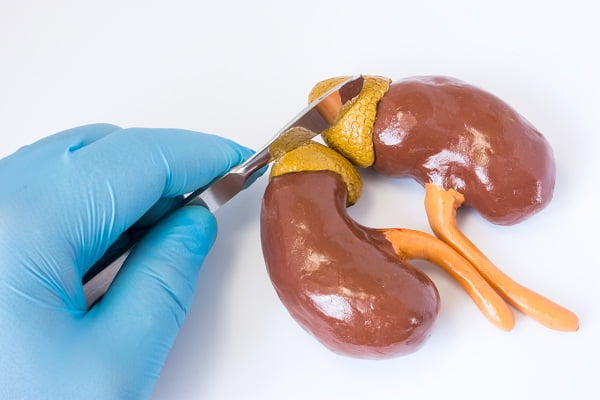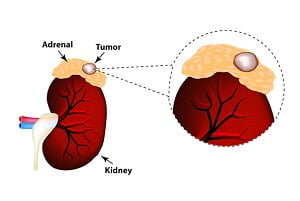What are adrenal glands?
The adrenal glands are two small glands that are located on top of each kidney. They’re part of your endocrine system that produces hormones. Adrenal glands produce hormones that are necessary for many bodily functions to occur. These hormones include such as sex hormones and cortisol.
Your adrenal glands are responsible for a variety of hormone-related functions in the body. Any disorders of the adrenal glands can affect your health significantly.
Adrenal glands anatomy, shape, size, and location: Where are my adrenal glands located?
Your adrenal glands are two small triangular-shaped organs. The dimension of adrenal glands is about 1.5 inches in height and 3 inches in length. They are located on top of your each kidney. The name adrenal refers to their location: ‘ad’ which means ‘at’ and ‘renes’ means ‘kidneys’.
Shape and size of adrenal glands: The right adrenal gland is generally more like a pyramid in shape and the left adrenal gland is more like a crescent. The right adrenal gland has a maximum width of about 6.1 mm and the left adrenal gland has a maximum width of about 7.9 mm.
The adrenal glands are located on top of each kidney.
Each adrenal gland is comprised of these structures:
- the outer part of the adrenal glands, which is called the adrenal cortex.
- the inner region, which is known as the adrenal medulla
What is adrenal cortex?
The adrenal cortex is the outer part of the adrenal gland and is responsible for the production of hormones that are necessary for life, such as cortisol. Cortisol helps regulate metabolism and allows your body to respond to stress. It also produces aldosterone which helps control your blood pressure.
The adrenal cortex includes three main zones. Each zone can be recognized and distinguished from one another based on structural and anatomic characteristics. These zones are:
- Zona glomerulosa
- Zona fasciculate
- Zona reticularis
The outermost layer, called the zona glomerulosa, is the main site for production of aldosterone by the action of an enzyme called aldosterone synthase. Aldosterone is primarily responsible for the regulation of your blood pressure.
The zona fasciculata is responsible for producing glucocorticoids and cortisol. Cortisol is the main glucocorticoid and it helps in mobilization of fats, proteins, and carbohydrates.
The inner most layer of the adrenal cortex, called the zona reticularis, produces androgens, such as dehydroepiandrosterone (DHEA), androstenedione (which is a precursor to testosterone), and DHEA sulfate.
The innermost adrenal cortical layer, the zona reticularis, lies adjacent to the medulla.
What is adrenal medulla?
The adrenal medulla is part of your adrenal gland. The adrenal medulla is located at the centre of each adrenal gland. It is surrounded by the adrenal cortex and is the innermost region of your adrenal gland. The adrenal medulla releases its secretions directly into the blood.
Medullary cells are derived from the embryonic neural crest and are simply modified neurons. The adrenal medulla is considered a ganglion of the sympathetic nervous system as a cluster of neuron cell bodies.
The adrenal cortex and adrenal medulla are enclosed in an adipose capsule that forms a protective layer around your adrenal gland.
The adrenal glands are controlled by pituitary gland, which is another part of your endocrine system. Pituitary gland is the main controller of your endocrine glands and is located in the head. Abnormal signals from the pituitary gland can tell your adrenal glands to produce different levels of the hormones than needed. This can cause your adrenal glands to produce too little or too much hormone resulting in hormonal imbalances.
Adrenal glands function: What do your adrenal glands do?
Hormones and adrenal glands: What hormones do my adrenal glands produce?
The function of adrenal glands in your body is to produce certain hormones and enter directly into the bloodstream. Many of these hormones are responsible for allowing your body to respond to stress. Some of these hormones are vital for life. The two parts of the adrenal glands — the adrenal cortex and the adrenal medulla — perform well-defined, distinct, and separate functions.
While adrenal cortex produces hormones that are vital for existence, the hormones produced by medulla are not like this. Each of the zones of the adrenal cortex secretes a specific hormone. The key hormones produced by the adrenal cortex are:
Cortisol
Cortisol is a glucocorticoid hormone that is produced in the zona fasciculata region of the adrenal cortex. It helps perform several important functions in the body such as control the use of fats, proteins and carbohydrates in the body, regulate the blood pressure, and increases blood sugar. It also helps decrease bone formation.
Dehydroepiandrosterone (DHEA) and Androgenic Steroids
These are weak male hormones produced by the zona reticularis. Dehydroepiandrosterone (DHEA) is an endogenous androgenic steroid produced by the ovaries and adrenal glands. They are converted in the ovaries into female hormones (estrogens) and in the testes into male hormones (androgens).
Aldosterone
Aldosterone is a hormone that is produced by zona glomerulosa in the adrenal gland. It plays an important role in regulating the blood pressure and certain electrolytes such as sodium and potassium. Aldosterone sends signals to your kidneys so that they regulate usage and release of sodium and potassium in the bloodstream and urine. It, therefore, also helps regulate the blood pH by controlling the levels of these electrolytes in the blood.
Epinephrine (Adrenaline) and Norepinephrine (Noradrenaline)
The adrenal medulla helps control certain hormones that help you manage physical and emotional stress. These hormones secreted by the adrenal medulla include such as:
- epinephrine (adrenaline)
- norepinephrine (noradrenaline)
Other functions of these hormones are:
- help increase the heart rate and force of heart contractions
- help increase the blood flow to the muscles and brain
- help in relaxing smooth muscles
- assist in sugar metabolism
- control the squeezing of blood vessels
- help maintain blood pressure
Epinephrine and norepinephrine are generally released in stressful situations to manage strain and stress in the body.
Adrenal gland disorders and diseases: What can go wrong with my adrenal glands?
Adrenal glands can cause health issues in these two ways:
- by producing too little hormones
- by producing too much of certain hormones
Any of these problems can lead to hormonal imbalances in the body. These problems associated with the adrenal glands can be caused by various diseases of the adrenal glands or the pituitary gland. Some of the common diseases and conditions of adrenal glands are:
Adrenal Insufficiency and adrenal crisis
Adrenal insufficiency is a condition in which the adrenal glands do not produce enough amounts of steroid hormones, mainly cortisol. It may also include disturbed production of aldosterone, a hormone which regulates sodium conservation, potassium secretion, and water retention in the body.
The main causes of adrenal insufficiency are:
- autoimmune disorders
- fungal and other types of infections
- cancer
- genetic changes
Adrenal deficiency mostly occurs gradually, but sometimes it can appear suddenly as an acute adrenal failure. This condition is called adrenal crisis.
Congenital Adrenal Hyperplasia
Congenital adrenal hyperplasia is a genetic disorder that can cause adrenal insufficiency. Children who are born with this disorder do not have essential enzymes necessary to produce cortisol and/or aldosterone.
Children may not show symptoms of congenital adrenal hyperplasia and the disease can remain undiagnosed for years depending on the severity of the deficiency of the enzyme.
Overactive Adrenal Glands
Sometimes, adrenal glands may produce too much of certain hormones. Nodules may develop in the glands that are responsible for the excess production of certain hormones. These nodules may be 4 centimeters or larger in size. These nodules may sometimes be cancerous. Both benign and cancerous nodules may produce excessive amounts of certain hormones. This condition is referred to as overactive adrenal gland.
- Excess production of cortisol hormone can cause diseases such as cushing Syndrome
- Excess production of aldosterone hormone can cause diseases such as hyperaldosteronism
- Excess production of adrenaline or noradrenaline hormones can cause diseases such as pheochromocytoma
Adrenal Cancer
Malignant adrenal tumors (called adrenal cancer) such as adrenocortical carcinoma can develop in adrenal glands. These cancers are rare though but grow large. Adrenal cancer often spreads to other organs and tissues by the time they are diagnosed.
Adrenal cancer may cause other problems such as production of certain hormones in excess. Not all cancers in adrenal glands start from the adrenal glands. Most adrenal cancers are secondary cancers, that is, they start somewhere else in the body and spread to the adrenal glands after metastasis.
Read also: Adrenal cancer
Read also: Stage 4 Adrenal Cancer – Survival and Treatment: Where Does Adrenal Cancer Spread?
Neuroblastoma of adrenal glands
Neuroblastoma is a type of cancer that forms in certain types of nerve tissue mostly in children. It generally starts from one of the adrenal glands, but can also develop in the neck, chest, abdomen, or spine. Read about neuroblastoma.
Neuroblastoma tumors most commonly develop in the adrenal glands, located on top of the kidneys, where neuroblasts are most commonly found. But neuroblastoma can also begin in or spread to other areas such as the chest, the spine or spinal cord regions and the abdomen.
Addison’s disease
This is a rare autoimmune disease that develops when your adrenal glands don’t produce enough cortisol or aldosterone.







